How to Select the Best Data Integration Platforms for Your Business
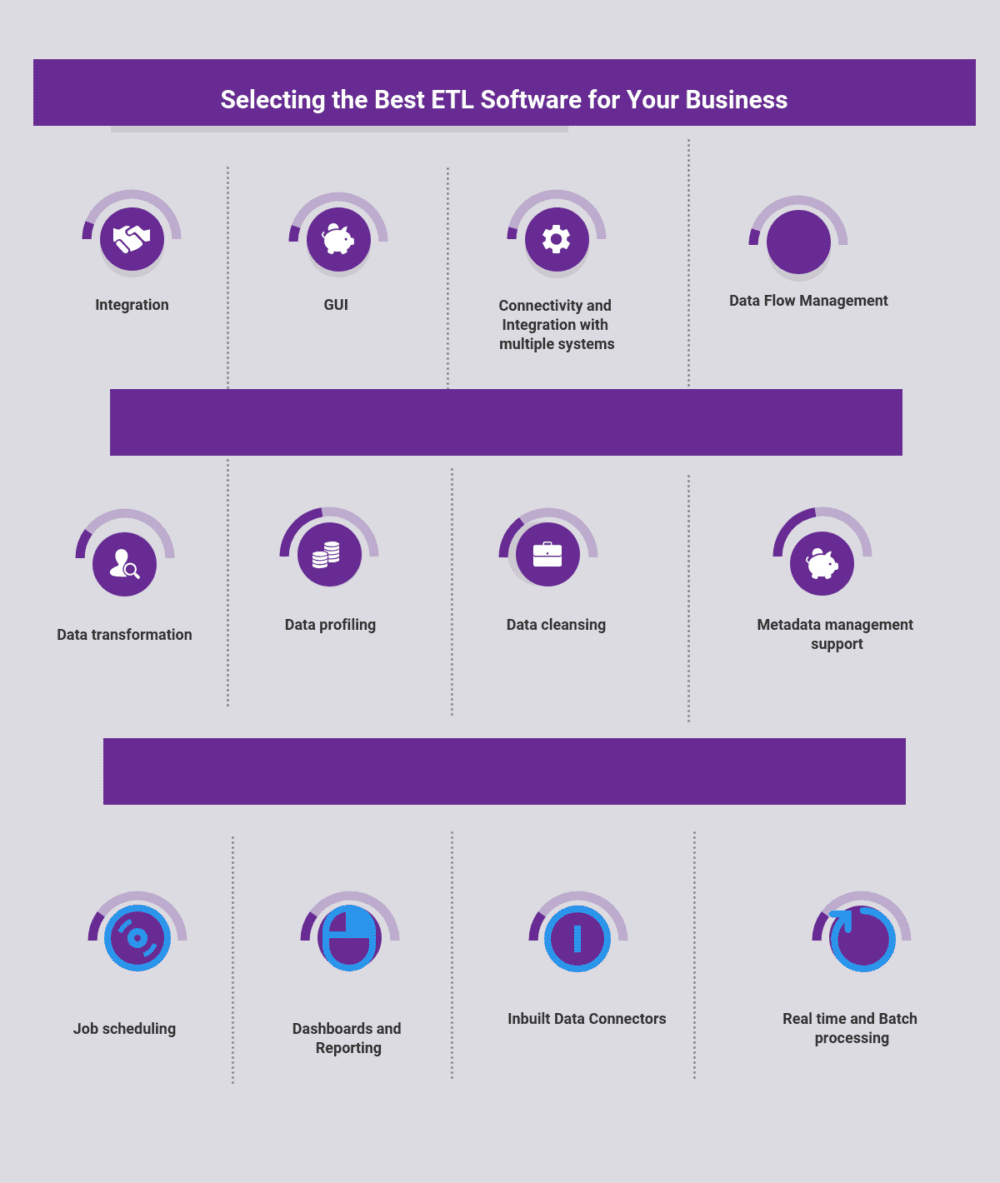
Data Integration platforms are software solutions that help organizations combine, clean, and manage data from disparate sources into a single, unified view. These platforms provide tools to automate data mapping, data extraction, data transformation, data loading, and data governance. They help organizations streamline data integration processes and enable data-driven decision making by providing a unified and consistent view of data.
Extract, Transform, Load (ETL) is a process in data warehousing. ETL Software helps in Data extraction, Data Transformation and Data Loading. Data extraction is where data is extracted from homogeneous or heterogeneous data sources, data transformation is where the data is transformed for storing in the proper format or structure for the purposes of querying and analysis; data loading where the data is loaded into the final target database such as an operational data store, data mart, or data warehouse.
ETL software is integrated data that comprise of three processes: extraction, transforming, and loading. The software is used to combine data from multiple sources into a single programming solution. The first process involves sourcing data from specific external databases and extracting desired portions of data. Secondly, the software transforms the acquired data into a format that can be analyzed. This is done by using predefined rules or lookup tables to create comprehensive data that fit the operational needs of a business.
The third process then loads the resulting data into a target database (such as a data warehouse). In the 1970s businesses used various databases to store pertinent information for their operations. However, there was a growing need to integrate and standardize the data before storing it in one location. This gave rise to the introduction of ETL software. Later on, data warehouses were created and are used to house the integrated data.
Extract, Transform, Load (ETL) refers to a process in data warehousing, which is used to Extract, Transform, Load data. Data extraction is where data is extracted from homogeneous or heterogeneous data sources; data transformation is where the data is transformed for storing in the proper format or structure for the purposes of querying and analysis; data loading is where the data is loaded into the final target database.
You may like to read: Top Data Integration Platforms
What are Data Integration Platforms?
Data Integration platforms are comprehensive solutions that help organizations unify and manage their data from various sources into a single, consistent view. These platforms provide a range of tools and features to automate and streamline data integration processes such as data mapping, extraction, transformation, loading, and governance. They help organizations overcome the challenges of data silos, inconsistent data definitions, and data quality issues by providing a unified and consistent view of their data. These platforms can integrate data from a variety of sources, such as databases, cloud applications, and file systems, and can support different integration styles, such as batch processing, real-time streaming, and event-driven. Data Integration platforms also provide features such as data lineage tracking, error handling and logging, security and privacy, and data auditing to ensure the integrity and accuracy of the data. By providing a unified view of data, Data Integration platforms enable organizations to make data-driven decisions and improve the efficiency and effectiveness of their data operations.
ETL systems commonly integrate data from multiple applications (systems), typically developed and supported by different vendors. ETL tools are able to communicate with the many different relational databases and read the various file formats used throughout an organization. ETL tools have started to migrate into Enterprise Application Integration, or even Enterprise Service Bus, systems that now cover much more than just the extraction, transformation, and loading of data. Many ETL tools now have data profiling, data quality, and metadata capabilities.
The importance of ETL software is demonstrated by its range of automated processes that can help streamline business operations. One valuable capability of the software is the ease of access to historical data. ETL software enables businesses to retrieve historical data that is useful in providing context and a comprehensive understanding of the business over time.
Secondly, ETL synchronizes and cleanses the data, thereby resulting in accurate and comprehensive reports. This is especially useful to allow managers to analyze and report on data that is relevant to particular daily activities or new projects. Another reason why businesses use ETL software is the enjoyment of greater productivity among IT/data employees. Automated processes that are built into the software eliminate the need for technical staff to spend hours on manual coding. Finally, businesses can benefit from the software’s capability to support trending integration requirements for activities such as streaming.
What are the Features of Data Integration Platforms?
Data Integration Platforms typically offer a range of features that help organizations unify and manage their data effectively. Some of the common features include data mapping and transformation, data extraction and loading, data governance and management, data quality and error handling, data lineage tracking, security and privacy, real-time streaming and batch processing, and data auditing and reporting. Data mapping and transformation tools help define how data from different sources is transformed into a consistent and unified format, while data extraction and loading tools automate the process of pulling data from sources and loading it into the platform. Data governance and management features ensure data accuracy and security, while data quality and error handling tools monitor data for errors and provide alerts when issues arise. Data lineage tracking enables organizations to understand where data comes from and how it flows through the platform, while security and privacy features ensure that sensitive data is protected. Real-time streaming and batch processing capabilities allow organizations to handle large volumes of data in real-time or in batch mode. Finally, data auditing and reporting features provide organizations with insights into data usage, performance, and trends, enabling organizations to make informed decisions.
ETL software provides features such as Integration, GUI design, Team-based development capabilities, Data transformation, Data profiling, Data cleansing, Metadata management support, Job scheduling, and Dashboards and Reporting.
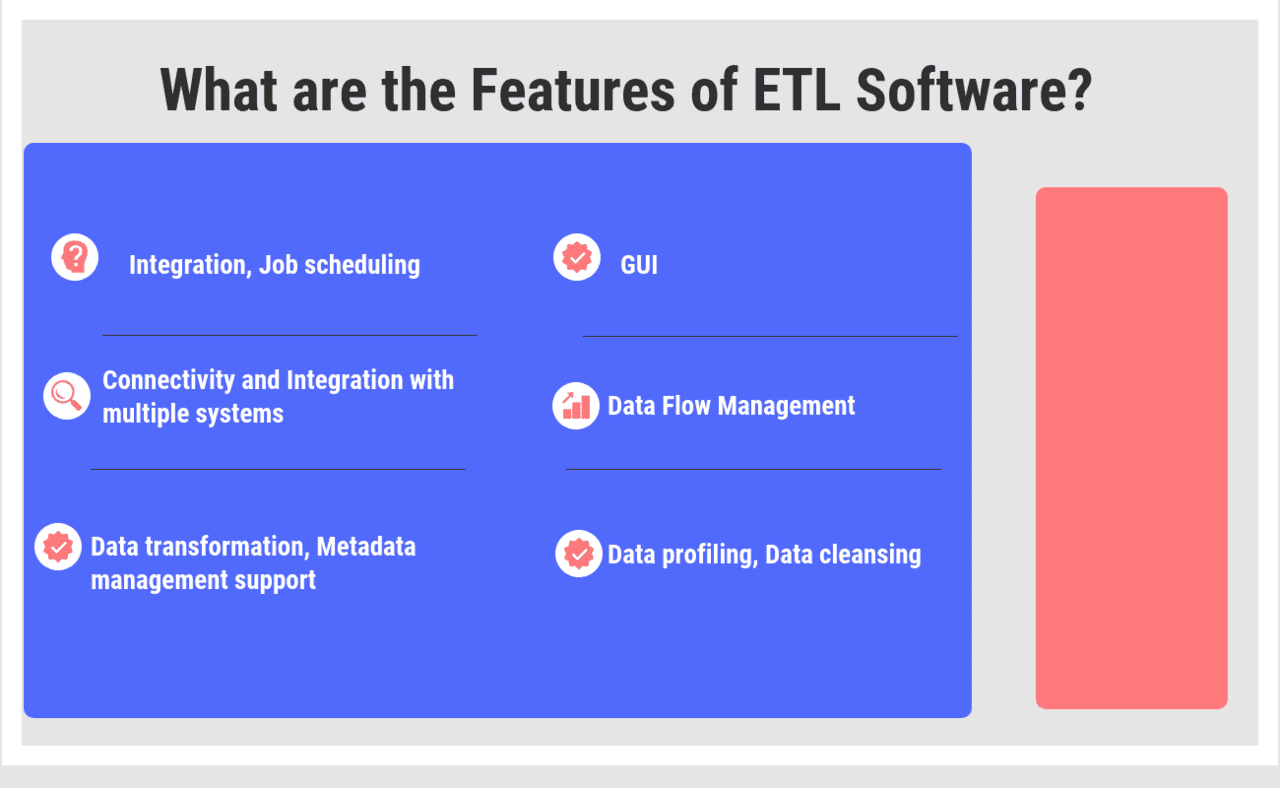
What are the Features of ETL Software
- Integration: Enables businesses to extract data from various databases and combine the data into one robust platform
- GUI: Facilitates drag and drop actions for easy development of mappings and workflows, and to enable non-technical users to easily navigate the software
- Connectivity and Integration with multiple systems: Connects and integrate with multiple systems with built in connectors.
- Data Flow Management : Provides data flow management.
- Data transformation: Facilitates activities such as conversion of data type, reformatting of dates, data mapping, and workflow arrangement
- Data profiling: Capable of analyzing source data for accuracy, consistency, and other characteristics before starting the ETL process
- Data cleansing: Identifies and fixes any data that is incorrect, inconsistent or incomplete
- Metadata management support: Synchronizes integration processes and records data transformation and business guidelines
- Job scheduling: Provides activities such as monitoring of jobs, notification of job completion, performance monitoring and report scheduling
- Dashboards and Reporting: Provides managers with accurate and comprehensive information that will allow them to observe performance and trends, essential for decision making
You may like to read: Top Data Integration Platforms and Top Guidelines for a Successful Business Intelligence Strategy
What are the Types of ETL Software
- Code-based: This traditional type uses programming tools that support a range of operating systems and programming languages.
- GUI-based: The use of icons and other user-friendly visual aids allows users to view and perform activities without having to learn coding languages.
- Metadata Support: This type maps the source data to the intended target database. Metadata-driven ETL software involves the creation of templates to control data migration and the management of data mapping rules.
- Batch processing: The software can process high volumes of data (such as payroll) in groups of limited sizes that are predetermined by the business. One major advantage of this is that processing can occur overnight or during periods of inactivity to avoid disruption of daily operations.
- Real-time processing: Unlike batch processing, data is processed in shorter time periods and provides users with immediate updates. However, real-time processing involves frequent input, process, and output of data e.g. ATM operations.
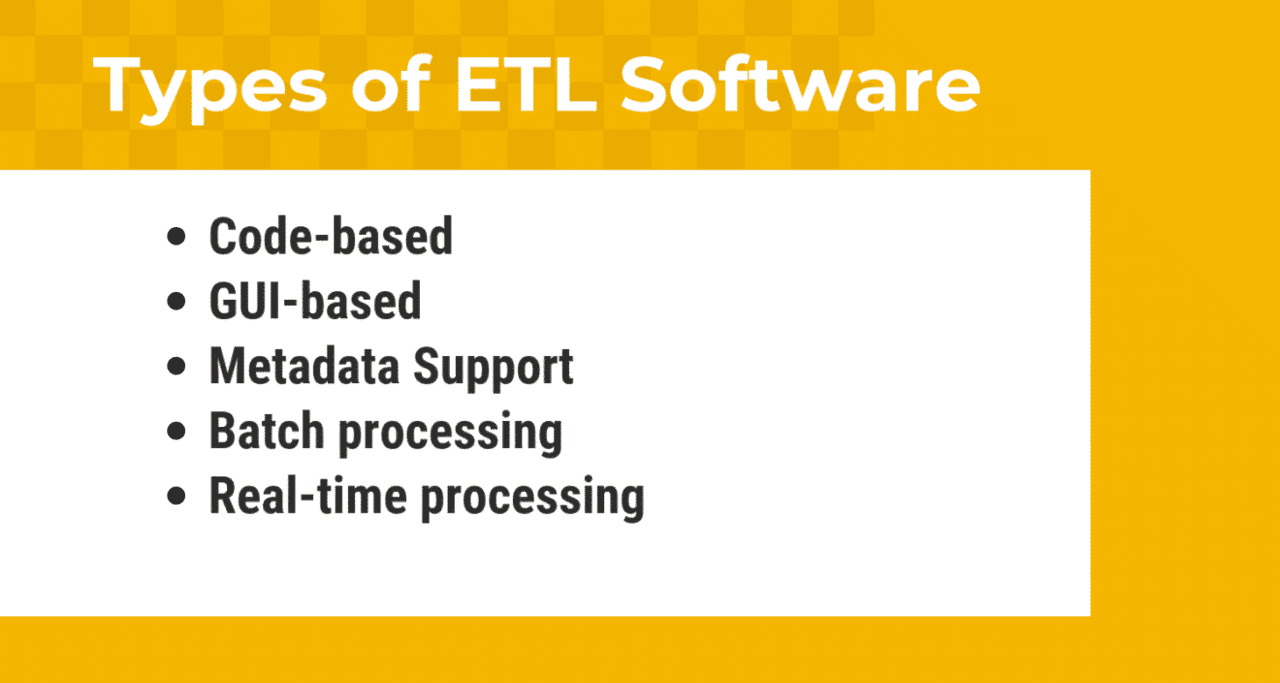
What are the Types of ETL Software
What are the Key Performance Indicators (KPI's) of ETL Software
- Data processing time: Calculates the number of records that are extracted, transformed and loaded within a specific period of time
- Average query response time: Calculates the average time the software takes to process a query
- Source reject:Evaluates the software’s ability to reject any data that differs from the metadata that was created by the developer
- Target reject:Assesses software’s ability to reject processed data that contains data that differs from the predetermined target metadata
What are the Benefits of Data Integration Platforms
Data Integration Platforms bring numerous benefits to organizations, including improved data accuracy and consistency, increased operational efficiency, better decision making, enhanced security and privacy, and reduced costs. By integrating data from disparate sources into a unified view, these platforms eliminate data silos and inconsistent data definitions, resulting in a more accurate and consistent view of data. Automating data integration processes and streamlining workflows also leads to increased operational efficiency and reduces the time and effort required to integrate data. With a unified view of data, organizations can make better, data-driven decisions and gain new insights into their operations. Additionally, Data Integration Platforms provide security and privacy features to ensure that sensitive data is protected, and they can help reduce the costs associated with data integration by automating manual processes and reducing the need for custom integrations. Overall, Data Integration Platforms help organizations unlock the value of their data and drive growth and innovation.
- Ease of Use: ETL identifies data sources and has predetermined rules for extracting and processing data. Based on the selection criteria, ETL then processes and loads the data. This automated approach makes it much easier than the traditional programming process to obtain consolidated information.
- Graphical flow: GUI allows users to quickly manipulate the flow of data by simply using a drag and drop interface to show the smooth process. This interface contributes to the usability benefit of the software.
- Operational resilience: ETL tools have a built-in system to deal with any error functionality that may present itself. It uses the standards for operating and monitoring the systems.
- Structured designs: ETL can move data in a structured manner from internal to external sources, and integrate data from multiple locations.
- Lineage and Analysis: Better decisions can be made when software is able to help determine the source of information (Data Lineage), and show how the data is manipulated before a report is generated (Impact Analysis).
- Data profiling and cleansing: Profiling tools evaluate content, structure, and quality of the data and identify violations, while data cleansing detects and removes errors.
- Complex Data Management: ETL tools provide a better platform for moving and transferring data into batches. This process is made easy since the tasks are simplified and multiple sets of structured and unstructured data are integrated.
You may like to read: Top Data Integration Platforms and Top Guidelines for a Successful Business Intelligence Strategy
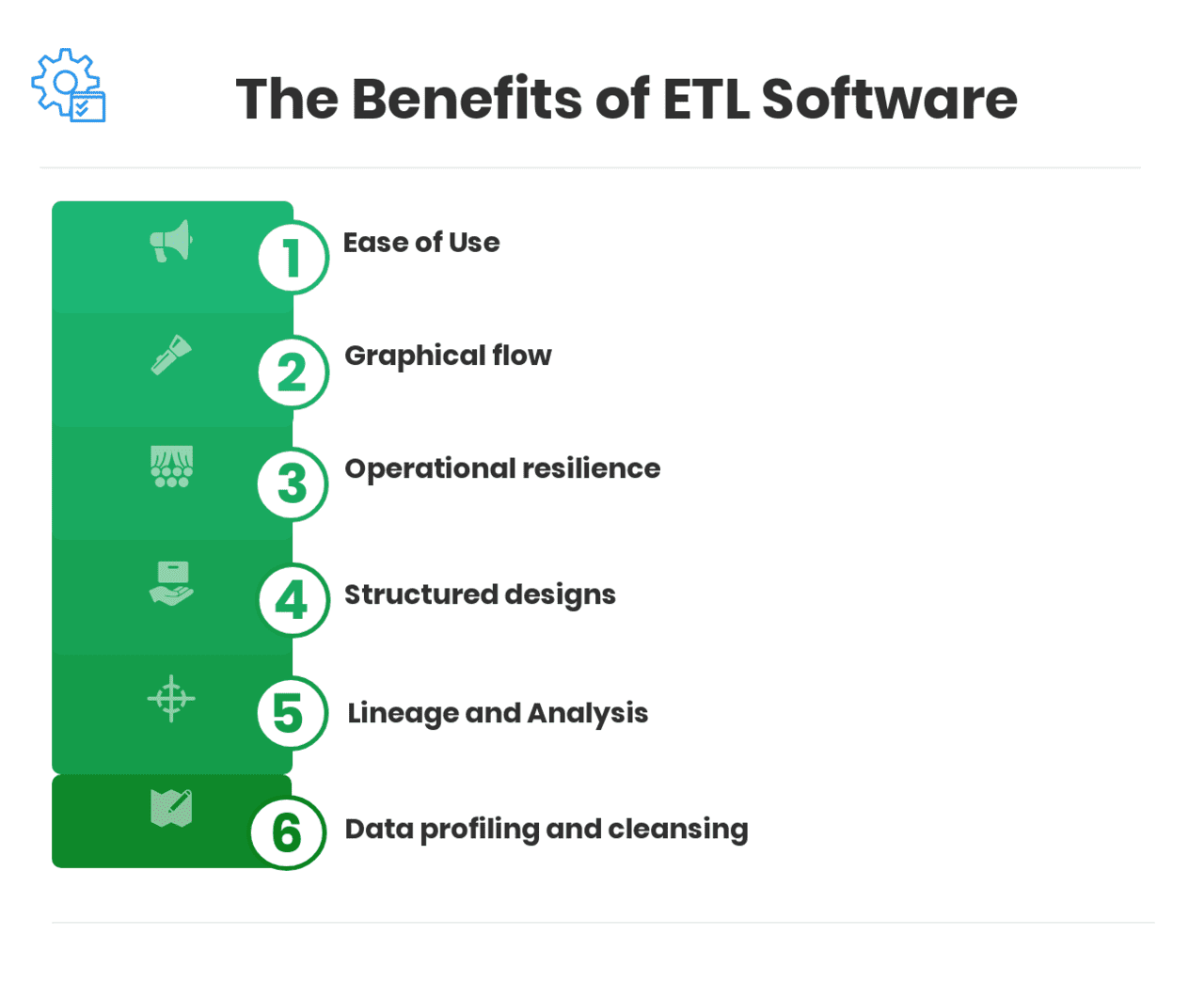
The Benefits of ETL Software
What are the Latest trends in ETL Software
- Shift from in-house to cloud-based solutions: More businesses are acquiring cloud-based ETL tools from external service providers. This approach saves on cost and time and gives businesses the opportunity to focus on core operations.
- Shift from batch to real-time processing: There is a growing need for immediate access to data, which has fueled the switch to real-time processing. Real-time processing allows for quicker decision-making rather than delays experienced in batch processing.
- Data pipeline: This is a cloud-based automated service that easily moves data between sources, which allows business to readily access and transform information. Data pipeline will improve the efficiency of some aspects of ETL testing and will eliminate others.
How to choose the right Data Integration Platforms?
Selecting the most appropriate ETL software can be a tedious task. However, businesses should consider the following factors to guide their selection: Supporting connectivity, Usability, Supporting systems, Debugging, Reusability, Scalability, and Real-time processing.
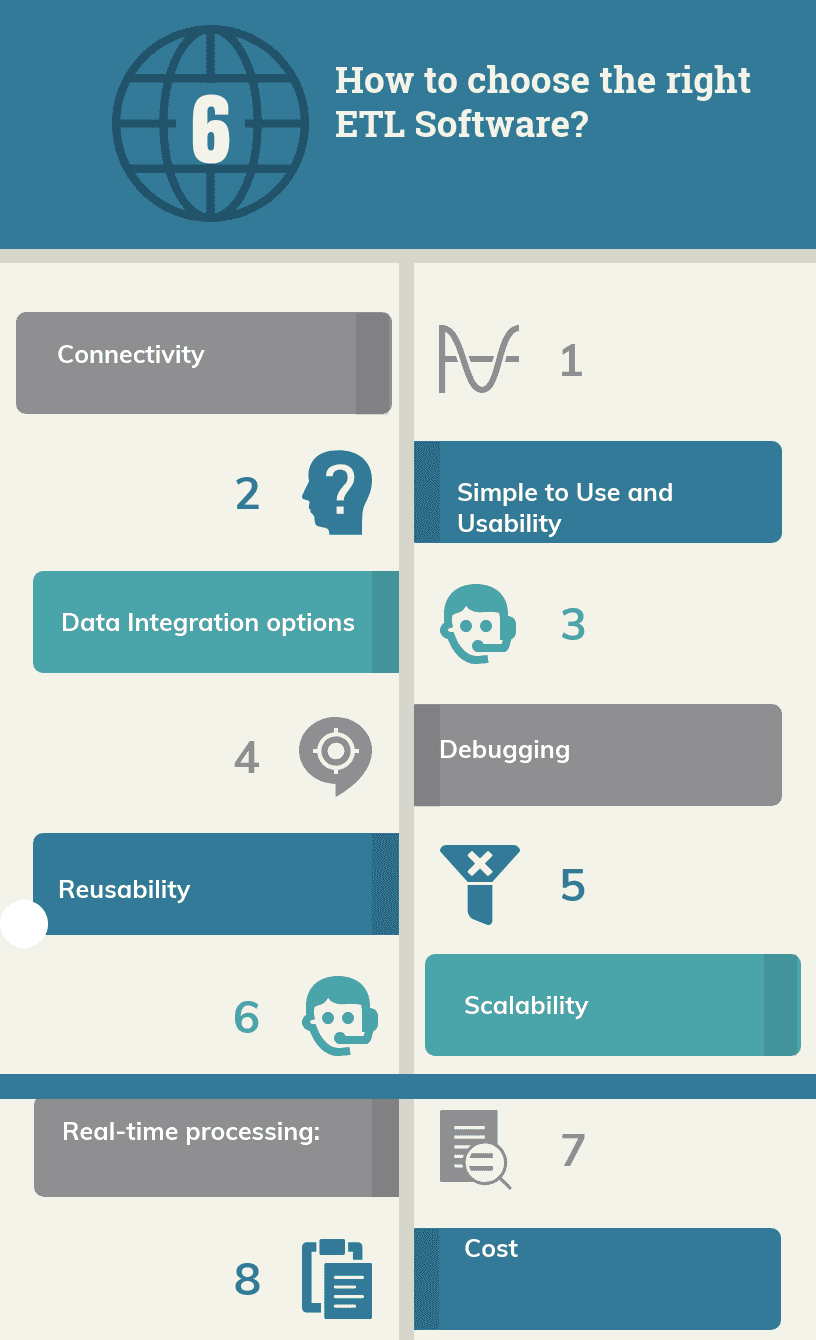
How to choose the right ETL Software
- Connectivity: Businesses should see if the tool supports data cleansing, metadata and data profiling. The number of applications that can read the metadata as well as the number of queuing products that can be connected is also important.
- Simple to Use and Usability: The product must be easy to learn and use. The software should have a screen that makes viewing comfortable on the eyes, as well as a simple layout. If training is necessary, it should be built into the software and be easy to manipulate.
- Data Integration options: Current ETL tools are produced to be able to handle structured data from numerous sources which include spreadsheets, XML format, and UNIX application systems. The difficulty could arise if the data is not structured in an organized manner, since this may be a challenge for the ETL tool. Therefore businesses should see if the tool supports other platforms.
- Debugging: This facility is also used as a checkpoint in quality control. Businesses should determine if the processes can run in an orderly step by step process. Another consideration is whether or not the system can postpone the running if an error is detected or if various conditions are not met.
- Reusability: The components of the software must be reusable and be able to function within various parameters. The ability of the processes to separate into smaller components is also an asset since modular programming may be necessary.
- Scalability: Business should also consider if ETL software can run on different machines. The different steps in the ETL process should be easily accommodated and, in many cases, be distributed to multiple hubs between the data source and target.
- Real-time processing: Does the ETL tool provide for the data to be moved from internal to external sources and be transformed in real time? Can this data be provided in an integration batch? Businesses should consider if there are mechanisms in the software to determine if and how changes to the system are detected.
- Cost : Cost of using the software : One time fee and subscription charges per user per year.
Top Free Data Integration Platforms
You may like to read: Top Free Data Integration Platforms
Top Data Integration Platforms
You may like to read: Top Data Integration Platforms
What are Data Integration Platforms?
ETL systems commonly integrate data from multiple applications (systems), typically developed and supported by different vendors. ETL tools are able to communicate with the many different relational databases and read the various file formats used throughout an organization.
What are the Features of Data Integration Platforms?
ETL software provides features such as Integration, GUI design, Team-based development capabilities, Data transformation, Data profiling, Data cleansing, Metadata management support, Job scheduling, and Dashboards and Reporting.

























































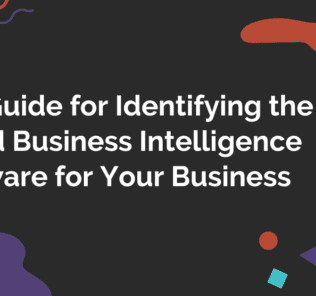
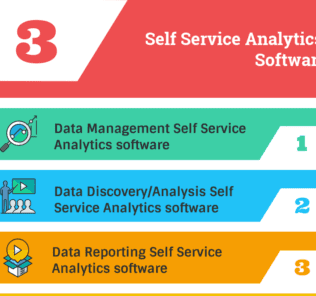
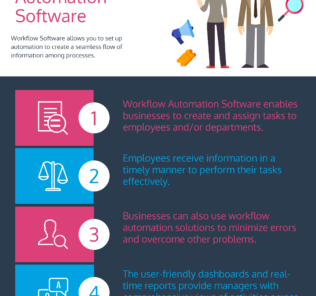
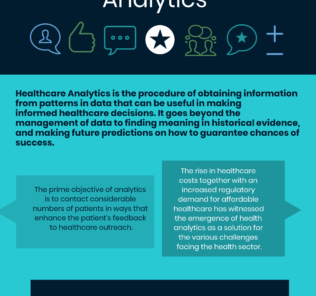
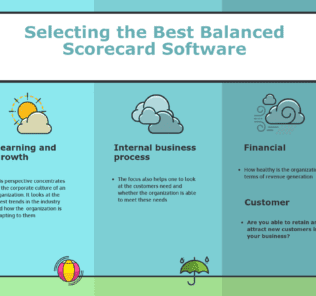
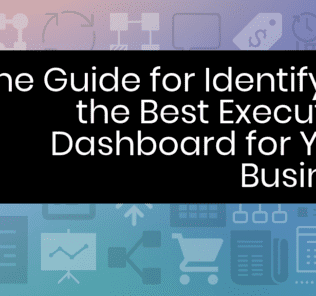




ADDITIONAL INFORMATION
Thanks for sharing how data integration platforms is working in depth. And explaining the benefits of Data Integration Software.